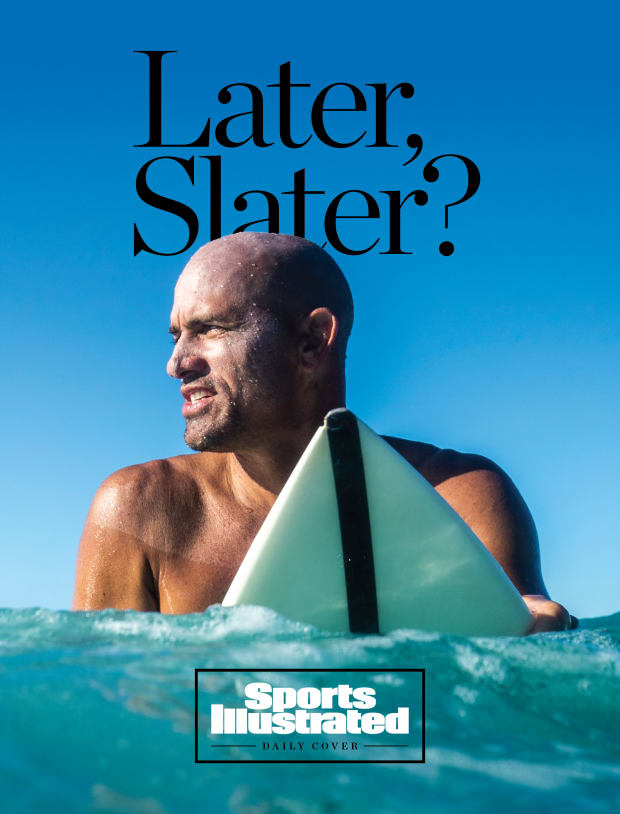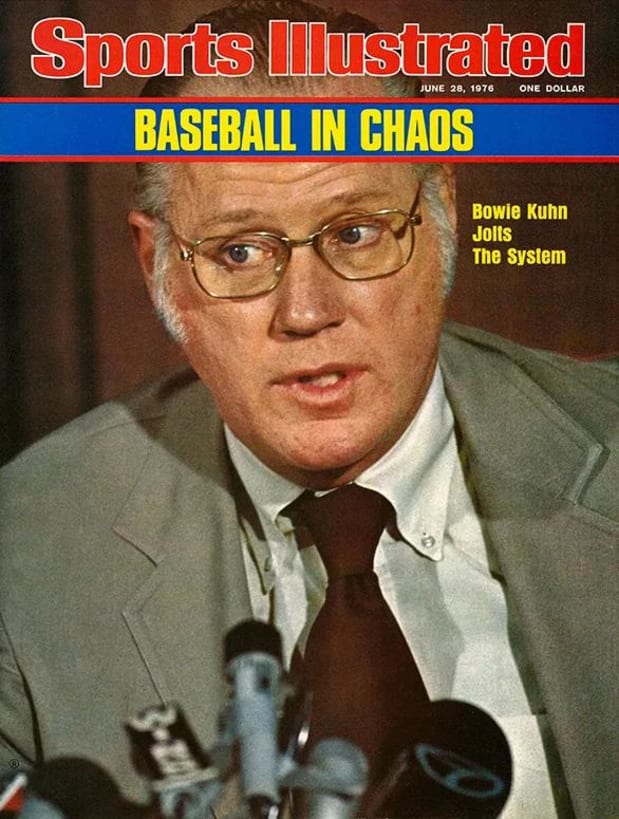Good morning, I’m Dan Gartland. The chaos hasn’t started yet but the NBA offseason is about to heat up.
In today’s SI:AM:
🏄♂️ Kelly slays
If you're reading this on SI.com, you can sign up to get this free newsletter in your inbox each weekday at SI.com/newsletters.
No bombshell in Brooklyn
Kyrie Irving almost started the NBA offseason with a bang. After spending the past few days toying with the media as he weighed his future with the Nets, Irving has reportedly decided to exercise his player option and remain in Brooklyn.
In what has now become typical fashion, he confirmed the news by issuing the following pseudo-intellectual statement to Shams Charania of The Athletic:
“Normal people keep the world going, but those who dare to be different lead us into tomorrow. I’ve made my decision to opt in. See you in the fall. A11even.”
So Irving, who had reportedly been granted permission to seek sign-and-trade partners, is locked into playing for the Nets next season. Or, more accurately, he’s locked into getting paid $36.5 million next season. There’s nothing stopping the Nets from trading him if the relationship sours. The only thing opting into his contract precludes is a sign-and-trade deal like the one he had reportedly been hoping to swing with the Lakers. But if Irving had engineered a sign-and-trade with the Lakers, he would have had to take a $30 million pay cut to fit under Los Angeles’s salary cap.
Opting in means that we’ll likely get to see how the Nets’ new big three of Irving, Kevin Durant and Ben Simmons meshes. If it works like the team is hoping, then Brooklyn could be one of the top teams in the East. If it goes poorly, then it’s easy to envision a scenario in which a disgruntled Irving, playing on an expiring contract, demands to be shipped elsewhere. And, as ESPN’s Kevin Pelton writes, “In some ways, Irving exercising his option makes a trade easier than trying to find a mutually agreeable sign-and-trade deal if he became a free agent.”
Even with Irving under contract for next season, the Nets can’t exactly spend their summer kicking their feet up at the beach. They still have plenty of holes to fill on a team that was probably the most disappointing in the NBA last season. Perhaps the most pressing issue is figuring out the center situation. Andre Drummond, LaMarcus Aldridge and Blake Griffin are all free agents, while Nic Claxton is a restricted free agent. The Nets have their core figured out but the complementary pieces can be what makes a championship team.
With Irving staying put, here’s what passes for major news so far this offseason: John Wall is reportedly being bought out by the Rockets and planning to sign with the Clippers. Wall didn’t play at all this season due to a disagreement with the Rockets. (The team wanted him to come off the bench, Wall refused, and the team agreed to sit him until it could find a trade partner, which, given his enormous contract, was never going to happen.) The addition of Wall and the return of Kawhi Leonard make the Clippers an interesting team to watch next season, but there will be far more compelling transactions made when free agency opens for real on Thursday evening.
The best of Sports Illustrated

Todd Glaser
In today’s Daily Cover, Brandon Sneed checks in on another sports GOAT excelling in his later years—50-year-old surfer Kelly Slater:
“He’s been around this sport for 40-odd years, but still he’s competing on the World Surf League Championship Tour, where he’s claimed 11 world titles, including once as the youngest winner ever (at 20) and once as the oldest (39). Along the way, through relentless success and the kind of charm that landed him a recurring role on Baywatch, he helped take surfing mainstream. Some would argue that he’s accomplished more in his sport, and done more for it, than any other athlete across time.”
Rohan Nadkarni ranks the top 25 NBA free agents available this summer. … Tom Verducci looks at the curious case of Juan Soto, who just cannot hit breaking balls this season. … Conor Orr believes that these 10 players could make their first Pro Bowl in 2022.
Around the sports world
MLB handed out 12 suspensions as a result of the Angels-Mariners brawl. … Dan Snyder is refusing to accept a subpoena to testify before Congress. … MLB will reportedly waive its relocation fee if the A’s move to Las Vegas. … The “Ninja Warrior” obstacle course is under consideration to become the fifth discipline of the modern pentathlon at the 2028 Olympics in Los Angeles. … Texas added another big football recruit in the wake of Arch Manning’s commitment. … Pioneering Black quarterback Marlin Briscoe has died at 76.
The top five...
… plays from the night in baseball:
5. Pirates prospect Oneil Cruz’s first home run of the season
4. Giancarlo Stanton’s long home run into the bleachers
3. Yonathan Daza’s throw to nail a runner tagging up
2. Tyler Wade’s diving play at third
1. Meibrys Viloria catching a bat that flew out of a hitter’s hands
SIQ
What was the margin by which the Supreme Court ruled in Muhammad Ali’s favor in the case Clay v. United States on this day in 1971?
Yesterday’s SIQ: Which Mets pitcher set a major league record by losing his 24th consecutive decision on June 27, 1993?
Answer: Anthony Young. The streak began in 1992 and stretched to 27 games before it was finally snapped.
Young bounced between the rotation and the bullpen during his time with the Mets. He got the start on June 27, 1993, and gave up five runs on eight hits as the Mets lost to the Cardinals 5–3. The loss snapped the previous big league record for consecutive losses set by Cliff Curtis of the Boston Braves from 1910–11.
Young wasn’t as terrible a pitcher as 27 consecutive losses makes him sound. His ERA was under 5 during the streak—not great but also not historically awful—and picked up 16 saves during that time. But those were some lousy Mets teams. The 1992 team went 72–90, while the ’93 squad was a dismal 59–103. Lots of Mets pitchers were picking up losses—Pete Schourek went 5–12 in ’93 and Frank Tanana was 7–15—Young just happened to drop a bunch in a row.
Young’s streak was finally snapped on July 28, 1993 against the expansion Marlins. He seemed destined to take a 28th straight loss after giving up the go-ahead run in the top of the ninth. But the Mets scored two in the bottom of the inning, capped by Eddie Murray’s walk-off hit, and Young’s teammates mobbed him after the winning run scored.
“That wasn’t even a big monkey that was on my back,” Young later said. “It was a zoo. The guys treated it like I had won a World Series game for them.”
Young pitched three more years in the majors with the Cubs and his hometown Astros. He died in 2017 after being diagnosed with an inoperable brain tumor.
From the Vault: June 28, 1976

Neil Leifer/Sports Illustrated
I suspect a fair number of MLB team owners today would love to do what A’s owner Charlie Finley tried to do in June 1976.
Just hours before the June 15 trade deadline, Finley struck deals with the Red Sox and Yankees to sell three star players (Vida Blue to New York and Joe Rudi and Rollie Fingers to Boston) for a total of $3.5 million. All three players would be free agents after the season and, having failed to find a trade to his liking, Finley decided to cash out instead.
It was the final step in a historic fire sale. The A’s, who had won the AL West five years in a row and captured three straight World Series from 1972–74, had already sent Reggie Jackson and Ken Holtzman to the Orioles in April. Now Finley was trying to get rid of three more key players.
Commissioner Bowie Kuhn refused to let the deals move forward, though. Citing his duty to look out for the good of the game, Kuhn stepped in and put the sales on hold while calling a meeting with the parties involved. After three days of discussions, Kuhn announced that he was voiding the sale.
“If such transactions now and in the future were permitted, the door would be opened wide to the buying of success by the more affluent clubs, public suspicion would be aroused, traditional and sound methods of player development and acquisition would be undermined and our efforts to preserve competitive balance would be greatly impaired,” Kuhn declared.
The important context behind Kuhn’s decision is that it came at the dawn of free agency, right as Marvin Miller and the players association were launching the most significant challenge to the reserve clause yet. The more modestly wealthy of baseball’s owners were concerned that their more fabulously wealthy peers might end up simply buying winning rosters.
Finley took Kuhn to court but a federal judge ruled that the commissioner did have the authority to nullify the sales, which is probably the only reason why the Pirates, Reds and Orioles aren’t just selling veterans for cash these days.
Check out more of SI’s archives and historic images at vault.si.com.







